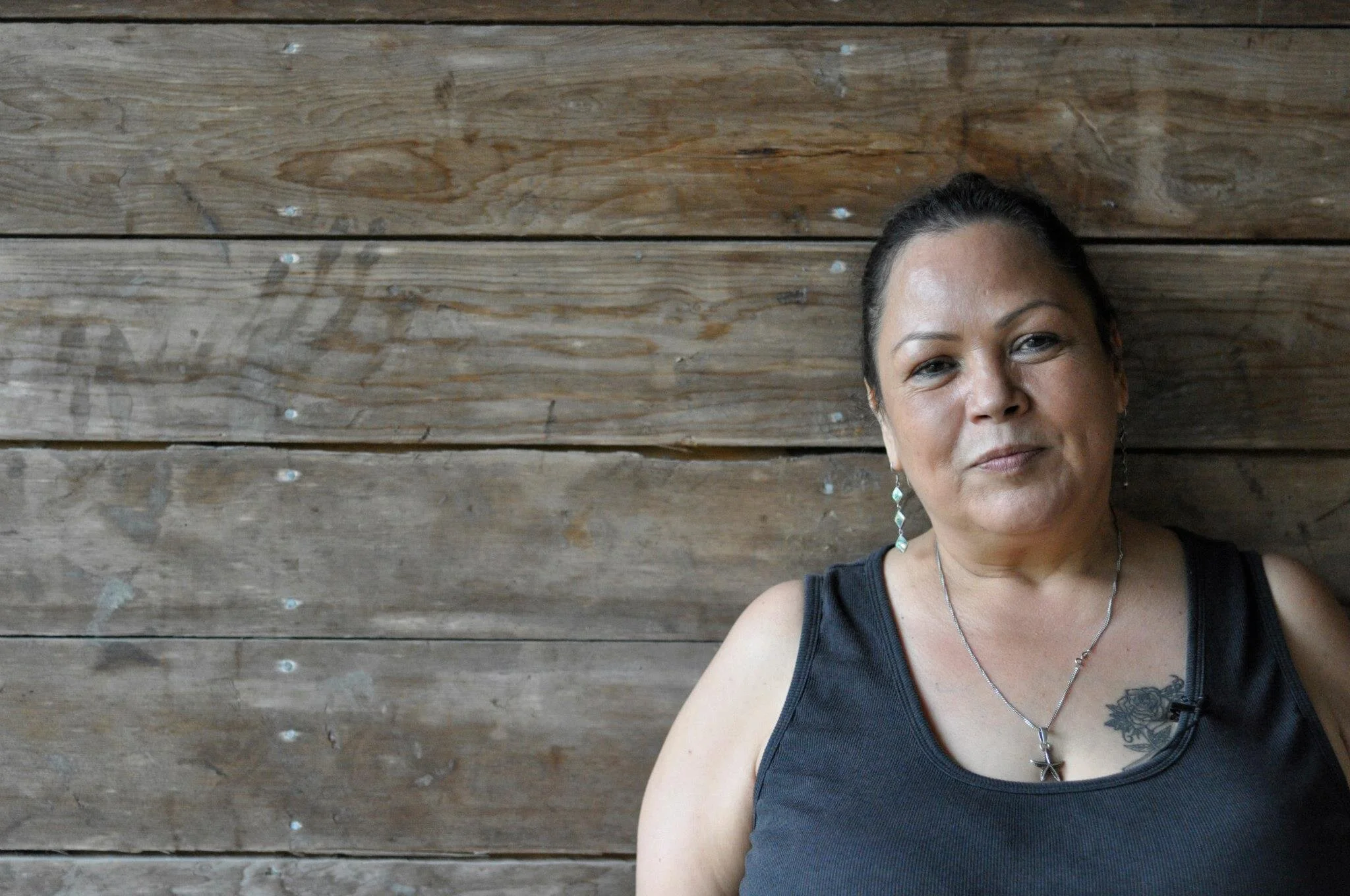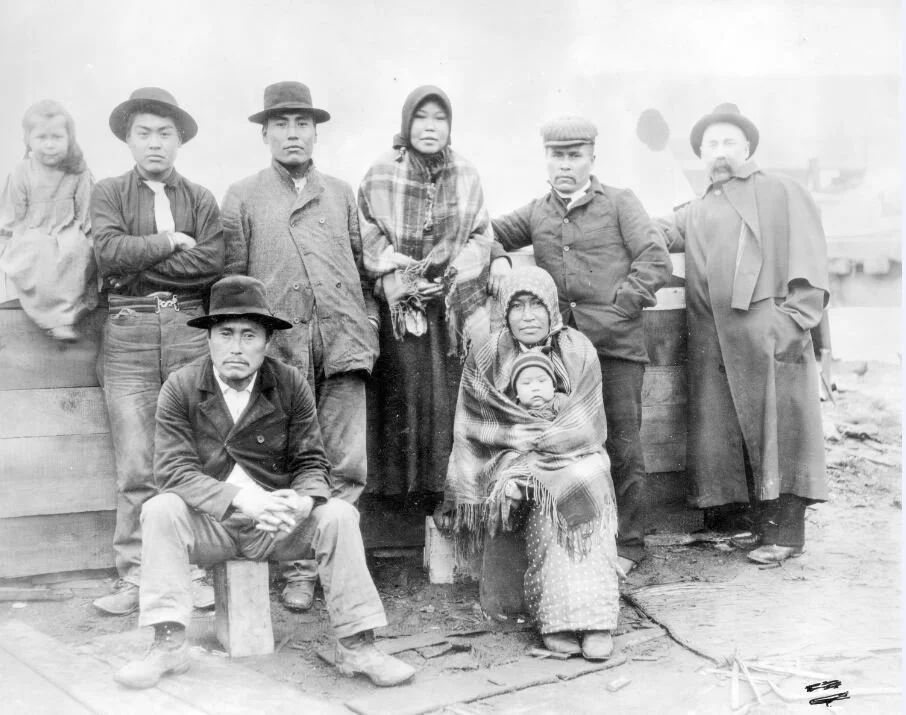Indigenous artists and knowledge keepers share untold stories of Vancouver’s Eastside in In the Beginning
The cultural-sharing events will fill in blanks in the area’s recorded past, prior to and during colonization
Sahtu Dene and Coast Salish artist, writer, and storyteller Rosemary Georgeson hopes that In the Beginning: A Cultural Sharing will lead to a deeper understanding of what’s now known as Vancouver. Photo by Jessica Hallenbeck
In the Beginning: A Cultural Sharing takes place as part of the 2020 Downtown Eastside Heart of the City Festival, November 4 to 7 at the Firehall Arts Centre, with streaming to follow
AS FAR BACK as she can remember, Rosemary Georgeson has called the water home. The Sahtu Dene and Coast Salish artist, writer, and storyteller spent the first 30 years of her life fishing, trolling the Salish Sea near Galiano Island, sometimes as far as Prince Rupert. Her father was a commercial fisherman, just like his father; her mother and grandmother also fished and knew the waters like the back of their hands. The waterfront was always a gathering place for the family. But while her ancestors’ connection to the oceans runs deep, tracing their history as keepers and caregivers of the sea has been as difficult as swimming against the current. Like that of other Indigenous people, her family’s past has been largely erased through the omissions of settler colonists’ archives.
“I come from a fishing family,” Georgeson tells Stir via Zoom. “We have always been on the water. Some of my first memories were being on the boat with my dad.”
Her father also travelled in and out of Vancouver Harbour for work, and through that, she has had a long connection to Vancouver’s East Side. Reaching further depths of her background, however, has proven challenging.
“My family story is very broken,” she says. “I’ve been doing a lot of research trying to find my grandfather’s family. Due to the impact of contact and colonization, he was taken from his mom and didn’t know who his family was. There have been a lot of incidents where church and state have flat-out lied in the last 20 years to me about my grandfather’s story.”
Getting to the truth of that story drove Georgeson to join Donna Spencer, artistic producer of the Firehall Arts Centre, on a deep dive into the history of Indigenous people before and during colonization on the traditional territories of the Musqueam, Squamish, and Tsleil-Waututh Nations in the area now known as Vancouver. This collaboration led to In the Beginning: A Cultural Sharing. Presented and produced by the Firehall and Vancouver Moving Theatre as part of the 2020 Downtown Eastside Heart of the City Festival, the collection of five sharing events takes place from November 4 to 7.
Moderated by educator Kim Haxton, Potawatomi from the Wasauksing First Nation, the series consists of what could be called chapters: Over the Mountains, From the Waters, Musqueam, Tsleil-Waututh, and Squamish. Each segment will feature unscripted discussions with Indigenous elders, knowledge keepers, story-tellers, artists, and activists from the Musqueam, Squamish, and Tsleil-Waututh territories as well as those who came down rivers and across waters or mountains to the region, including members of Cree and Haida Nations. They will share tales, memories, and personal photos, helping fill in so many blanks in the recorded history of the area, particularly the East Side and the neighbourhoods known as Strathcona, Chinatown, Gastown, and Paueru Gai (Powell Street).
It’s history that goes far further than the arrival of steamboat captain “Gassy” Jack Deighton in the 1860s from England, even though many official documents refer to him as the “Father of Gastown”. A statue in his honour stands at the junction of Carrall, Powell, and Water streets, in Maple Tree Square, the former site of the saloon he ran. What’s far less known is that he married a Squamish woman in the late 1860s, and, after her death, wed her niece, who was just 12 years old. Her name was X̱áliya, but she was given the name Madeline. (According to Squamish oral history passed down through elders, she fled Deighton when she was 15.)
The fact that X̱áliya’s story has gone widely unrecognized by settlers is just one example of the countless tales that need to be told, Spencer says. Many years ago, the Firehall did a project based on the book Opening Doors—In Vancouver's East End: Strathcona. Last year, through discussions with Vancouver Moving Theatre artistic director Savannah Walling, interest was renewed in revisiting the history of the East Side. Spencer, Georgeson, and Walling embarked on more research, turning to archival resources, books, and other materials. What stood out was what wasn’t there.
“It was very obvious we needed to hear from Indigenous people in this community and in the Greater Vancouver area to tell the complete story of the neighbourhood and how it became what it is today and what happened to those stories that weren’t told,” Spencer says during the same Zoom call.
First Nations camped Alexander Beach ca. 1898. Public Domain. Vancouver City Archives
Early on, Spencer and Georgeson imagined writing a play based on their research, but it became very clear very quickly that these stories would and should only be told by people who lived them. “It was really obvious that I did not have the knowledge to see how we would shape a play around this; I didn’t feel it was my place,” Spencer says.
Georgeson relates: “I don’t have the right to create stories for the host Nations or for anyone who came into this territory for different reasons. We need to hear their own voices, to have each Nation speak about why they made Vancouver their home and about their connection to Eastside, to the land, and what the land was used for before contact.
“We looked at maps of where creeks used to be, fish-bearing streams that are underground now, that are gone,” Georgeson says. “To hear from the people who lived there, who knew what used to be there, seemed like the important place to go with this. There’s no way we had the right to create a piece around their stories.”
The way the creative team sees things, In the Beginning is just the beginning.
“So much of what you hear, see, and read in the media and on social media, and the history written in books, is so inaccurate and so untrue; we didn’t want to go there again,” Georgeson says. “I can’t wait to start hearing the stories, to witness these events.
“People who know the stories have a right to share the stories, and people have a right to know the truth,” she says. “I hope we can create space to hear more stories and further our understanding of this land—and how people survived for time immemorial on it.”















